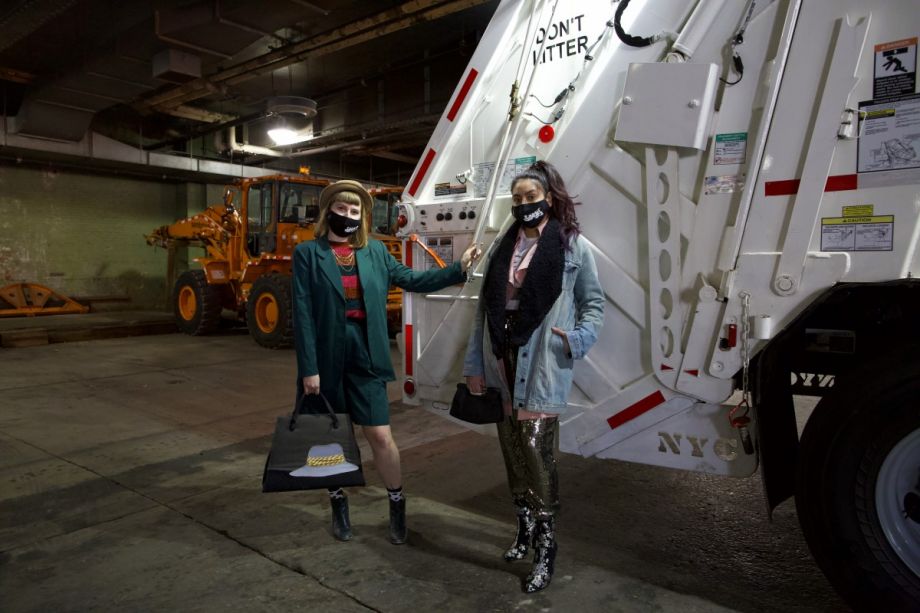
Models wearing clothing sourced from donations to Housing Works and Big Reuse, for Refashion Week NYC. (Stylist: Sheryl Roberts; Photographer: Charlie Eisenbach; photo courtesy DSNY)
Indigo dyed fabrics, tote bags from plastic waste, colorful 3-D printed shoes — and restyled, donated garments. That’s just a handful of what you’re likely to see walking into New York’s annual Refashion Week.
Refashion Week, which begins this week, is co-produced by the Sanitation Foundation and donateNYC. It’s designed to build awareness around the environmental impact of the fashion industry, and encourage people to be more conscious of their style choices. It’s also designed to make them aware of local solutions.
“I think there’s a growing awareness around the problem, which is great,” says Julie Raskin, head of the Sanitation Foundation and one of Refashion Week’s co-producers. “but I think what’s become more important is, there’s enough people now that know about this problem but don’t feel equipped to do anything about it.”
Every year, New Yorkers throw out 200,000 tons of clothing and textiles; that’s roughly 5,000 semi-trucks full, an enormous amount of waste. One locally-based answer to that waste is the city’s donateNYC platform and sister textile recycling program, refashionNYC.
“It’s like, the best-kept secret that we wish weren’t a secret,” Raskin adds.
Here’s how the refashionNYC program works. First, residents can file a request with the Department of Sanitation for a bin to be installed, either in an office building, a school or other institutional building, a commercial business, or an apartment building with 10 or more units. The Department of Sanitation will meet with a representative of the building — the landlord, business manager, etc. — to approve the request, then deliver the bin. When the bin is full, the building notifies the department of Sanitation and Housing Works arranges pickup.
After picking the material up, Housing Works sorts it in their warehouse, according to spokesperson Elizabeth Koke. Some donations are sold in their 10 thrift shops throughout the city or listed online, while others are sent to other nonprofit second-hand stores or exported to overseas markets. Even non-donatable goods — clothing too ripped, damaged, or dirty to be reworn — can be sold to a textile merchant to be “downstream recycled,” reprocessed as cleaning rags or seat padding.
“Things that may have a hole in it or kind of worn out, we’ll still take it in the bins,” says city Department of Sanitation spokesperson Belinda Mager. “We’ll still make use of it so it doesn’t end up in the landfill.”
To date, refashionNYC bins have been installed in nearly 1,300 locations. The majority of them are located in residential buildings, although Mager says the program also maintains bins in schools, some commercial establishments, and other agencies/institutions.
The refashionNYC program isn’t new; it started in 2011, almost ten years ago, and since then, it’s diverted more than 12,200 tons of clothing and textiles. But still, that’s only a drop in the bucket compared to the thousands of tons that go to waste annually. Would the city like to see the program expand?
Absolutely, both Raskin and Mager say. But resources for additional advertising and awareness campaigns are limited, so awareness is mainly spread through the city’s social media and website highlights, outreach staff mentions at meetings, events, or training programs, and word-of-mouth… and, of course, Refashion Week.
And the space requirements for the bins themselves — small bins are about the size of a small refrigerator, while large bins are a little less than double that — can also limit the amount of building managers willing to accommodate. “It is New York City,” says Mager, “and there’s hundreds of buildings in NYC with weird logistics, [that] weren’t built with recycling in mind.”
There’s also the limitation of Housing Works’ capacity, although Koke says the thrift store chain has a back up plan for that… the donations could be directed to other New York City second-hand stores and nonprofits, if necessary.
“We can scale up a bit at our warehouse, [and] if we reach beyond our capacity our contract with the city allows us to employ other non-profit subcontractors.”
“We would love to spread the word,” says Raskin. “We’ve thought about taking the show on the road and helping other cities put on their own Refashion Weeks.” But, she adds, a key part of the process is discussing actionable, transferable solutions; “I think that’s extremely valuable and necessary… I’m not sure the same [approach] would necessarily work in a less dense city, for example.”
As simple as the refashionNYC program may seem, there aren’t many parallels of it in cities across the country.
In Philadelphia, residents are cautioned to keep clothing and other textiles out of the recycling, since they’re not accepted in the city’s program (although just last year, the city announced a partnership with Retrievr that allows residents to schedule appointments and have the service pick up recyclable clothing at their doorstep; it’s not yet clear how often Philadelphians are making those appointments, or how much waste the service has managed to divert). In Washington D.C., the Zero Waste program promotes textile reuse, recovery and recycling — and maintains a directory of clothing donation locations — but doesn’t have any city-run programs for residents to divert that waste.
That doesn’t mean there aren’t other initiatives dedicated to reducing waste in cities. In Seattle, a campaign called Threadcycle, run jointly by King County Solid Waste Division and Seattle Public Utilities, allows residents to drop off clothing and textiles at dozens of sites or schedule for a pickup. Just this past year, Austin Resource Recovery partnered with Goodwill Central Texas to launch a curbside collection program for clothing and linen donations. And there’s other nationwide programs like Big Brothers Big Sisters or Gaia Movement that offer clothing collection boxes in certain local areas.
Still, it’s hard to beat the convenience of a donation bin in your apartment building.
This post was originally published on Next City.

